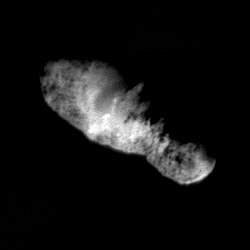19P/Borrelly
 | |
| Discovery | |
|---|---|
| Discovered by | Alphonse Borrelly |
| Discovery date | December 28, 1904 |
| Designations | |
| 1905 II; 1911 VIII; 1918 IV; 1925 VIII; 1932 IV; 1953 IV; 1960 V; 1967 VIII; 1974 VII; 1981 IV; 1987 XXXIII; 1994 XXX |
|
| Orbital characteristics | |
| Epoch 2022-08-09 (JD 2459800.5) | |
| Aphelion | 5.90 AU |
| Perihelion | 1.306 AU |
| 3.61 AU | |
| Eccentricity | 0.6377 |
| 6.85 yr | |
| Inclination | 29.30° |
| 2028-Dec-11 February 1, 2022 (last) |
|
| Earth MOID | 0.36 AU (54 million km) |
| Physical characteristics | |
| Dimensions | 8×4×4 km |
Mean radius |
2.4 km |
| Mass | 2×1013 kg |
Mean density
|
0.3 g/cm3 |
| Albedo | 0.03 |
|
| |
|
Perihelion distance at recent epochs |
|||||||
| Epoch |
Perihelion (AU) |
||||||
|---|---|---|---|---|---|---|---|
| 2028 | 1.310 | ||||||
| 2022 | 1.306 | ||||||
| 2015 | 1.349 | ||||||
| 2008 | 1.355 | ||||||
Comet Borrelly or Borrelly's Comet (official designation: 19P/Borrelly) is a periodic comet, which was visited by the spacecraft Deep Space 1 in 2001. The comet last came to perihelion (closest approach to the Sun) on February 1, 2022 and will next come to perihelion on December 11, 2028.
| Date & time of closest approach |
Earth distance (AU) |
Sun distance (AU) |
Velocity wrt Earth (km/s) |
Velocity wrt Sun (km/s) |
Uncertainty region (3-sigma) |
Reference |
|---|---|---|---|---|---|---|
| 2028-Dec-05 19:12 ± 6 min | 0.413 AU (61.8 million km; 38.4 million mi; 161 LD) | 1.31 AU (196 million km; 122 million mi; 510 LD) | 17.3 | 33.3 | ± 41 thousand km | Horizons |
Deep Space 1 returned images of the comet's nucleus from 3400 kilometers away. At 45 meters per pixel, it was the highest resolution view ever seen of a comet.
Discovery
The comet was discovered by Alphonse Borrelly during a routine search for comets at Marseilles, France on December 28, 1904.
Exploration
Deep Space 1 flyby

Deep Space 1 · 9969 Braille · Earth · 19P/Borrelly
On September 21, 2001 the spacecraft Deep Space 1, which was launched to test new equipment in space, performed a flyby of Borrelly. It was steered toward the comet during the extended mission of the craft, and presented an unexpected bonus for the mission scientists. Despite the failure of a system that helped determine its orientation, Deep Space 1 managed to send back to Earth what were, at the time, the best images and other science data from a comet.
